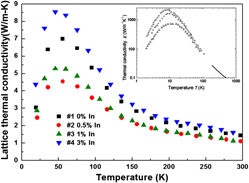Crossref Citations
This article has been cited by the following publications. This list is generated based on data provided by
Crossref.
Zhao, Huaizhou
Pokharel, Mani
Zhu, Gaohua
Chen, Shuo
Lukas, Kevin
Jie, Qing
Opeil, Cyril
Chen, Gang
and
Ren, Zhifeng
2011.
Dramatic thermal conductivity reduction by nanostructures for large increase in thermoelectric figure-of-merit of FeSb2.
Applied Physics Letters,
Vol. 99,
Issue. 16,
Datta, Anuja
and
Nolas, George S.
2012.
Synthesis and Characterization of Nanocrystalline FeSb2 for Thermoelectric Applications.
European Journal of Inorganic Chemistry,
Vol. 2012,
Issue. 1,
p.
55.
Datta, Anuja
and
Nolas, George S.
2013.
Thermoelectric Nanomaterials.
Vol. 182,
Issue. ,
p.
177.
Søndergaard, Martin
Johnsen, Simon
Sun, Peijie
Sun, Ye
Cenedese, Simone
Gatti, Carlo
Steglich, Frank
and
Iversen, Bo Brummerstedt
2013.
Thermoelectric Nanomaterials.
Vol. 182,
Issue. ,
p.
71.
Wang, Yongzheng
Fu, Chenguang
Zhu, Tiejun
Hu, Lipeng
Jiang, Guangyu
Zhao, Guanghui
Huo, Dexuan
and
Zhao, Xinbing
2013.
Hot deformation induced defects and performance enhancement in FeSb2 thermoelectric materials.
Journal of Applied Physics,
Vol. 114,
Issue. 18,
Koirala, Machhindra
Zhao, Huaizhou
Pokharel, Mani
Chen, Shuo
Dahal, Tulashi
Opeil, Cyril
Chen, Gang
and
Ren, Zhifeng
2013.
Thermoelectric property enhancement by Cu nanoparticles in nanostructured FeSb2.
Applied Physics Letters,
Vol. 102,
Issue. 21,
Pokharel, M.
Zhao, H. Z.
Koirala, M.
Ren, Z. F.
and
Opeil, C.
2014.
Enhanced Thermoelectric Performance of Te-doped FeSb $$_{2}$$ 2 Nanocomposite.
Journal of Low Temperature Physics,
Vol. 176,
Issue. 1-2,
p.
122.
Sanchela, Anup V.
Thakur, Ajay D.
and
Tomy, C.V.
2015.
Enhancement in thermoelectric properties of FeSb2 by Sb site deficiency.
Journal of Materiomics,
Vol. 1,
Issue. 3,
p.
205.
Duong, Anh Tuan
Rhim, S. H.
Shin, Yooleemi
Nguyen, Van Quang
and
Cho, Sunglae
2015.
Magneto-transport and thermoelectric properties of epitaxial FeSb2 thin film on MgO substrate.
Applied Physics Letters,
Vol. 106,
Issue. 3,
Zou, Tianhua
Xie, Wenjie
Feng, Jian
Qin, Xiaoying
and
Weidenkaff, Anke
2015.
Recent Developments inβ-Zn4Sb3Based Thermoelectric Compounds.
Journal of Nanomaterials,
Vol. 2015,
Issue. ,
p.
1.
Saleemi, Mohsin
Tafti, Mohsen Yakhshi
Jacquot, Alexandre
Jägle, Martin
Johnsson, Mats
and
Toprak, Muhammet S.
2016.
Chemical Synthesis of Iron Antimonide (FeSb2) and Its Thermoelectric Properties.
Inorganic Chemistry,
Vol. 55,
Issue. 4,
p.
1831.
Li, Jingjing
Yang, Zhe
Nkemeni, Darrin Sime
Zhang, Yuanzhi
Lou, Shiyun
and
Zhou, Shaomin
2021.
High Thermoelectric Figure of Merit of FeSb2−x Thin Films via Defect Engineering for Low-Temperature Cooling Applications.
Journal of Electronic Materials,
Vol. 50,
Issue. 12,
p.
6724.
Du, Qianheng
Tong, Xiao
Liu, Yu
and
Petrovic, C.
2021.
Suppression of thermal conductivity and electronic correlations in Fe1−xRuxSb2 (0 ≤x≤ 0.6).
Applied Physics Letters,
Vol. 118,
Issue. 17,
Theja, Vaskuri C. S.
Karthikeyan, Vaithinathan
Assi, Dani S.
and
Roy, Vellaisamy A. L.
2022.
Insights into the Classification of Nanoinclusions of Composites for Thermoelectric Applications.
ACS Applied Electronic Materials,
Vol. 4,
Issue. 10,
p.
4781.
Theja, Vaskuri C. S.
Karthikeyan, Vaithinathan
Assi, Dani S.
Huang, Hongli
Shek, Chan-Hung
and
Roy, Vellaisamy A. L.
2023.
Dispersion of InSb Nanoinclusions in Cu3SbS4 for Improved Stability and Thermoelectric Efficiency.
Advanced Energy and Sustainability Research,
Vol. 4,
Issue. 11,





